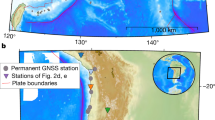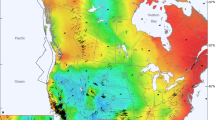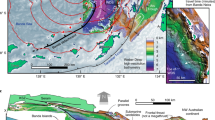Abstract
Transient tectonic deformation has long been noted within ∼100 km of plate boundary fault zones and within active volcanic regions, but it is unknown whether transient motions also occur at larger scales within plates. Relatively localized transients are known to occur as both seismic and episodic aseismic events1, and are generally ascribed to motions of magma bodies, aseismic creep on faults, or elastic or viscoelastic effects associated with earthquakes. However, triggering phenomena2,3 and systematic patterns of seismic strain release at subcontinental (∼1,000 km) scale along diffuse plate boundaries4,5 have long suggested that energy transfer occurs at larger scale. Such transfer appears to occur by the interaction of stresses induced by surface wave propagation and magma or groundwater in the crust6, or from large-scale stress diffusion within the oceanic mantle in the decades following clusters of great earthquakes7. Here we report geodetic evidence for a coherent, subcontinental-scale change in tectonic velocity along a diffuse ∼1,000-km-wide deformation zone. Our observations are derived from continuous GPS (Global Positioning System) data collected over the past decade across the Basin and Range province, which absorbs approximately 25 per cent of Pacific–North America relative plate motion. The observed changes in site velocity define a sharp boundary near the centre of the province oriented roughly parallel to the north-northwest relative plate motion vector. We show that sites to the west of this boundary slowed relative to sites east of it by ∼1 mm yr-1 starting in late 1999.
This is a preview of subscription content, access via your institution
Access options
Subscribe to this journal
Receive 51 print issues and online access
$199.00 per year
only $3.90 per issue
Buy this article
- Purchase on Springer Link
- Instant access to full article PDF
Prices may be subject to local taxes which are calculated during checkout




Similar content being viewed by others
References
Rogers, G. & Dragert, H. Episodic tremor and slip on the Cascadia Subduction Zone: The chatter of silent slip. Science 300, 1942–1943 (2003)
Hill, D. P. et al. Seismicity remotely triggered by the M 7.3 Landers, California, earthquake. Science 260, 1617–1623 (1993)
Prejean, S. G. et al. Remotely triggered seismicity on the United States west coast following the Mw 7.9 Denali Fault earthquake. Bull. Seimol. Soc. Am. 94, S348–S359 (2004)
Press, F. & Allen, C. Patterns of seismic release in the Southern California region. J. Geophys. Res. 100, 6421–6430 (1995)
Le Pichon, X., Chamot-Rooke, N., Rangin, C. & Sengör, A. M. C. The North Anatolian fault in the Sea of Marmara. J. Geophys. Res. 108, 2179, doi:10.1029/2002JB001862 (2003)
Brodsky, E. E., Roeloffs, E., Woodcock, D., Gall, I. & Manga, M. A mechanism for sustained groundwater pressure changes induced by distant earthquakes. J. Geophys. Res. 108, 2390, doi:10.1029/2002JB002321 (2003)
Pollitz, F. F., Bürgmann, R. & Romanowicz, B. Viscosity of oceanic asthenosphere inferred from remote triggering from earthquakes. Science 280, 1245–1249 (1998)
Elósegui, P., Davis, J. L., Mitrovica, J. X., Bennett, R. A. & Wernicke, B. P. Measurement of crustal loading using GPS near Great Salt Lake, Utah. Geophys. Res. Lett. 30, 1111–1114 (2003)
Smith, K. D. et al. Evidence for deep magma injection beneath Lake Tahoe, Nevada-California. Science 305, 1277–1280 (2004)
Bevington, P. R. & Robinson, D. K. Data Reduction and Error Analysis for the Physical Sciences 3rd edn (McGraw-Hill, Boston, 2003)
Ge, M., Gendt, G., Dick, G., Zhang, F. P. & Reigber, C. Impact of GPS satellite antenna offsets on scale changes in global network solutions. Geophys. Res. Lett. 32, L06310, doi:10.1029/2004GL022224 (2005)
Kedar, S., Hajj, G. A., Wilson, B. D. & Heflin, M. B. The effect of the second order GPS ionospheric correction on receiver positions. Geophys. Res. Lett. 30, 1829, doi:10.1029/2003GL017639 (2003)
Wernicke, B., Friedrich, A. M., Niemi, N. A., Bennett, R. A. & Davis, J. L. Dynamics of plate boundary fault systems from Basin and Range Geodetic Network (BARGEN) and geologic data. GSA Today 10, 1–7 (2000)
Hetland, E. A. & Hager, B. H. Postseismic relaxation across the Central Nevada Seismic Belt. J. Geophys. Res. 108, 2394, doi:10.1029/2002JB002257 (2003)
Gourmelen, N. & Amelung, F. Postseismic mantle relaxation in the Central Nevada Seismic Belt. Science 310, 1473–1476 (2005)
Dixon, J. E., Dixon, T. H., Bell, D. R. & Malservisi, R. Lateral variation in upper mantle viscosity: role of water. Earth Planet. Sci. Lett. 222, 451–467 (2004)
Hauser, E. et al. Crustal structure of eastern Nevada from COCORP deep seismic-reflection data. Geol. Soc. Am. Bull. 99, 833–844 (1987)
Allmendinger, R. W. et al. Overview of the COCORP 40°N transect, western United States: The fabric of an orogenic belt. Geol. Soc. Am. Bull. 98, 308–319 (1987)
Jarchow, C. M., Thompson, G. A., Catchings, R. D. & Mooney, W. D. Seismic evidence for active magmatic underplating beneath the Basin and Range Province, western United States. J. Geophys. Res. 98, 22095–22108 (1993)
Bennett, R. A., Davis, J. L., Normandeau, J. E. & Wernicke, B. P. in Plate Boundary Zones (eds Stein, S. A. & Freymuller, J. T.) 27–55 (AGU Geodyn. Ser. 30, Washington DC, 2002)
Wdowinski, S., Bock, Y., Zhang, J., Fang, P. & Genrich, J. Southern California permanent GPS geodetic array: Spatial filtering of daily positions for estimating coseismic and postseismic displacements induced by the 1992 Landers earthquake. J. Geophys. Res. 102, 18057–18070 (1997)
Acknowledgements
This work was supported by the National Science Foundation and the US Department of Energy. UNAVCO, Inc., supports BARGEN site implementation, operation and maintenance. The authors thank R. Bürgmann for comments on the manuscript.
Author information
Authors and Affiliations
Corresponding author
Ethics declarations
Competing interests
Reprints and permissions information is available at npg.nature.com/reprintsandpermissions. The authors declare no competing financial interests.
Rights and permissions
About this article
Cite this article
Davis, J., Wernicke, B., Bisnath, S. et al. Subcontinental-scale crustal velocity changes along the Pacific–North America plate boundary. Nature 441, 1131–1134 (2006). https://doi.org/10.1038/nature04781
Received:
Accepted:
Issue Date:
DOI: https://doi.org/10.1038/nature04781
This article is cited by
-
Seasonal components in GPS displacement time series
Acta Geophysica (2023)
-
Modelling and prediction of GNSS time series using GBDT, LSTM and SVM machine learning approaches
Journal of Geodesy (2022)
Comments
By submitting a comment you agree to abide by our Terms and Community Guidelines. If you find something abusive or that does not comply with our terms or guidelines please flag it as inappropriate.



